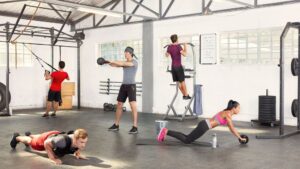What is Cross Training?
By including several forms of exercise into your regimen, you can give your body a more well-rounded set of skills that it can use as needed.
Your body will have acclimated to the same repeated action and workout of cycling if you use it as your primary training strategy. Crossing over into another area of training results in a more well-rounded set of abilities that the body can use as necessary.
A cyclist might occasionally incorporate running into their training regimen as an example of cross-training. Your body must adjust to get stronger and more fit because it is now being forced to do an unfamiliar task. This works for different muscle groups.

For whom is cross-training appropriate?
Regardless of how each of us defines enjoyment at the gym, we all want to enjoy our training. Everyone can benefit from cross-training. Balance, fitness levels, core strength, and strength may all be gained and improved upon by introducing variety to your training regimen, regardless of whether you’re a runner, cyclist, boxer, or yoga practitioner.
Advantages of cross training
Cross-training promotes diversity, which keeps things interesting and prevents boredom. Because your body is always adjusting to the many muscles that are being exercised, it also keeps your metabolism higher.
Behind the scenes, the neuromuscular adjustments brought about by cross-challenge training result in various muscle and connective tissue adaptations that improve flexibility and range of motion.
Injury prevention and healing
By enhancing your total fitness and providing joints and muscles with more mobility, stability, and strength, cross-training can aid in injury prevention and recovery.
Repetitive exercise, especially load- and resistance-bearing exercises, increase the risk of injury because it stresses bones, muscles, and joints over time.
Your risk of strains or sprains increases if you don’t give certain muscle groups enough time to recuperate and repair.
Being flexible makes it much simpler for you to move, so engaging in exercises like Pilates or yoga, for example, can help push your body beyond its comfort zone and advance your progress toward the training adaptation required for some particular sports.
Cross-training for a specific objective
Depending on what you need to improve, you can focus on your strength, endurance, balance, and flexibility by changing up your workout regimen:
Power and Resistance
Looking to shape and tone your body while maintaining bone health and strength? Why not include a kettlebell workout session, which enhances power and endurance while boosting stamina, strength, and fat-burning? When you squat, press, lift, and curl, BODYPUMPTM works all of your major muscle groups in one session.
Endurance
Improve your cardiovascular fitness by adding cycling—such as a Les Mills Sprint class or an Indoor Cycling Class—or by mixing it with running.
Whether you’re preparing for an event or just want some company when you run, joining the Human Race running club is a terrific way to improve your technique.
Nordic skiing is one of the most difficult types of aerobic training, and SkiErg machines replicate it. The single and double polearm techniques stress the upper body, core, and legs, as well as balance and fluidity.
Balance
Try Body Balance for a workout that leaves you long, strong, quiet, and focused and is influenced by yoga, tai chi, and pilates.
Barre classes: Through a sequence of ballet-inspired balances and stretches, this type of training lets you shape and tone your entire body.
A quick and efficient full-body workout using gravity and your weight is the TRX suspension class. TRX enables you to work for numerous muscle groups at once, whereas weight training only engages one or two at a time.
Flexibility
Yoga can increase flexibility and recovery from other types of exercise, and breathing exercises are especially beneficial for bikers and runners.
Swimming improves hip flexor and shoulder mobility as well as core strength. It has low impact, making it another excellent choice for active rehabilitation outside of your primary sport.
Suggested exercises for cross training
Cycling upper body exercises
Cycling’s constant riding position might cause you to become extremely tense.
Your upper body’s mobility and strength will improve as a result of this exercise.
How many sets should I perform? 2–3 sets for each exercise
What should my rep count be? 1 set of 12–15 repetitions
After completing the necessary number of sets for each exercise, move on to the following one.
- SkiErg
- Pullovers
- Kettlebell press
- Pallof press
- Side plank
Exercising the lower body for runners
Add this exercise to your schedule for actual gains that will carry over to your run. Strong legs and a strong core are essential for carrying you.
How many sets should I perform? 2–3 sets for each exercise
What should my rep count be? 1 set of 12–15 repetitions
After completing the necessary number of sets for each exercise, move on to the following one.
- Squats
- Deadlifts
- Plank
- Prowlers
Exercising the lower body for runners
Add this exercise to your schedule for actual gains that will carry over to your run. Strong legs and a strong core are essential for carrying you.
How many sets should I perform? 2–3 sets for each exercise
What should my rep count be? 1 set of 12–15 repetitions
After completing the necessary number of sets for each exercise, move on to the following one.
- Push-ups
- Pull-ups
- Walking lunges
- Kettlebell step-ups
- Goblet squats
Key learnings
Everyone can benefit from cross-training. You may build a healthy and balanced body by engaging in a variety of exercises that target each muscle group.
Speak to one of our knowledgeable personal trainers who would be pleased to assist you if you are unsure of whether cross-training exercises might enhance your training program.

No Comments
Leave Comment